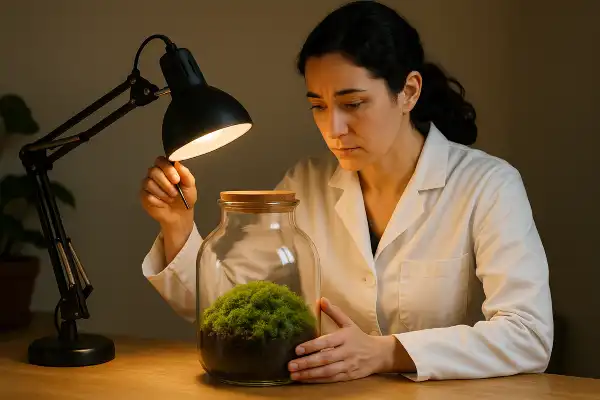How to light a terrarium becomes the silent question that determines whether your miniature ecosystem flourishes or merely survives. Plant enthusiasts often discover this challenge only after watching their carefully chosen specimens struggle in inadequate conditions.
Building terrariums taught me that lighting represents the invisible architecture of these enclosed worlds. The right placement and intensity can transform struggling plants into thriving miniature landscapes, yet many overlook this fundamental requirement until problems emerge.
Our question of June is: Is labradorite safe to use in damp terrariums?
How to light a terrarium?
Terrarium lighting requires either artificial light sources or strategic placement in well-lit rooms with natural lighting, maintaining 10-12 hours of daily exposure. Most terrarium plants thrive in bright indirect light conditions that mimic their natural rainforest environment.

Understanding light requirements for terrarium plants
Plants require specific wavelengths for photosynthesis, particularly violet-blue and orange-red light. Natural sunlight provides this complete spectrum with consistent energy distribution, while artificial sources vary significantly in their spectral output. Ferns typically need 1000-1500 lux for 10-12 hours daily, while moss requires 500-1000 lux for 8-10 hours.
The intensity of light diminishes rapidly with distance due to the inverse square law. Positioning lights 40-75mm from plants generally provides optimal photosynthetic conditions, though specific distances depend on the light source’s wattage and the plants’ tolerance levels.
Natural lighting placement strategies
Northern and eastern exposures provide gentle, cool light ideal for indirect light requirements, while southern windows deliver excessive intensity that can damage delicate terrarium plants. Direct sunlight causes terrarium glass to act as a magnifier, potentially burning plants and creating dangerous temperature spikes.
Strategic placement several feet away from south-facing windows can provide adequate illumination without harmful intensity. Filtered light through sheer curtains or blinds can weaken strong rays to healthy intensity levels. East-facing locations offer morning light that gradually increases, mimicking natural dawn conditions.
Artificial lighting solutions
LED grow lights have emerged as the preferred artificial lighting solution for terrarium applications. LED lights provide energy efficiency, minimal heat generation, and excellent light penetration with diode lifespans extending several years. LED strip lights offer versatility for custom installations and can be easily integrated into terrarium designs.
High-quality dimmable LEDs with ideal color spectrum provide plants with precise light amounts needed for healthy growth. Full-spectrum white LED lights eliminate the aesthetic issues associated with purple-tinted grow lights while delivering all necessary wavelengths for plant development.
Fluorescent lighting remains a cost-effective alternative for larger terrarium setups. T5 fluorescent bulbs provide approximately 95-100 lumens per watt, though they generate more heat than LED alternatives. T8 and T12 options offer cooler operation but reduced efficiency.
Establishing optimal light schedules
Terrarium plants require approximately 10-12 hours of daily light exposure to mimic natural daylight cycles. Plants need rest periods of at least 6 hours darkness daily, as continuous lighting eventually stresses plants and reduces chlorophyll production.
Timer systems ensure consistent light schedules without manual intervention. Automated timers eliminate the risk of forgetting light schedules and maintain the consistent photoperiods essential for plant health. Most terrarium enthusiasts find 10 AM to 8 PM lighting schedules align well with daily routines while providing adequate rest periods.
Distance and intensity considerations
Closer light placement typically results in faster plant growth, though excessive proximity can cause heat damage. LED spotlights work effectively for tall enclosures over 26 inches, focusing light into tight 60-degree beams for maximum penetration.
Heat management becomes critical with high-intensity lighting. LED lights can generate dangerous heat levels despite their efficiency reputation, requiring adequate ventilation and distance from heat-sensitive species. CFL bulbs produce even more heat, necessitating deeper light fixtures or elevated mounting to prevent leaf burning.
Troubleshooting common lighting problems
Insufficient lighting causes plants to become leggy and overgrown as they stretch toward available light sources. Conversely, excessive lighting creates rapid temperature increases and potential plant scorching. Fungus gnats often indicate overwatering combined with insufficient natural light.
Plant positioning within the terrarium affects light distribution. Mounting light-hungry plants higher in the terrarium brings them closer to light sources, maximizing intensity for species requiring stronger illumination. Regular glass cleaning ensures maximum light transmission, as dirty or foggy glass significantly reduces light penetration.
Conclusion
Last month, I repositioned three struggling terrariums from my south-facing office window to a filtered location near my east-facing kitchen window. Within two weeks, the previously pale moss developed rich green coloration, and the small ferns began producing new fronds. The careful attention to lighting principles transformed these miniature ecosystems from surviving to thriving, demonstrating how proper illumination serves as the foundation for successful terrarium cultivation.
El Castor is your exclusive terrarium guide.
